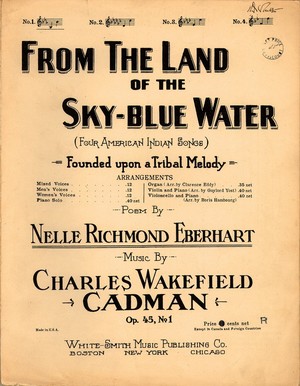
Search
From the Land of the Sky-Blue Water

"From the Land of the Sky-Blue Water" (1909) is a popular song composed by Charles Wakefield Cadman. He based it on an Omaha love song collected by Alice C. Fletcher. "Sky-blue water" or "clear blue water" is one possible translation of "Mnisota", the name for the Minnesota River in the Dakota language.
Composition
Cadman's collaborator, Nelle Richmond Eberhart, wrote a poem as the lyrics:
The song became widely popular after noted American soprano Lillian Nordica performed it in concert in 1909.
Representation in other media
- An arrangement of the song for harp and flute is performed by Harpo Marx in the 1940 Marx Bros. film, Go West.
- Blanche DuBois in A Streetcar Named Desire by Tennessee Williams sings a part of the song in Scene Two while she is in the bathroom.
- The first line, "From the Land of Sky-blue Water", is sung by the Three Stooges in the film The Three Stooges In Orbit (1962), at about the three-quarter point in the film, before they launch into space for the first time.
- The Hamm's Brewery used a version of the lyrics- "From the land of sky blue waters/ comes the beer refreshing" - as an advertising jingle through the mid-twentieth century, accompanied by pseudo-Native American drumming.
References
Bibliography
- Cadman, Charles Wakefield (m); Eberhart, Nelle Richmond (w). "Hamm's Brewery" (Sheet music). Boston : White-Smith Music Publishing Company (1909).
External links
- Sheet Music for Four American Indian Songs Op. 45 No. 1; words by Nelle Richmond Eberhart; White-Smith Music Publishing Co., 1909, includes music for "From the Land of the Sky-Blue Water"
- From the land of the sky-blue water – Florence Hinkle – Victor 60079 – Camden, New Jersey (1912-10-03) | National Jukebox LOC.gov
- From the land of the sky-blue water Musical score | Nebraska Memories
Text submitted to CC-BY-SA license. Source: From the Land of the Sky-Blue Water by Wikipedia (Historical)
Articles connexes
- The Land, the Water, the Sky
- Charles Wakefield Cadman
- Mount Blue Sky
- Go West (1940 film)
- Blue Sky Tower
- The Blue Sky Boys
- Blue-water navy
- Titanic: Music from the Motion Picture
- Blue–green distinction in language
- Yellowstone (film)
- Diffuse sky radiation
- Jeanette MacDonald
- Blue Water (missile)
- The Bride of Habaek
- Ocean color
- Castle in the Sky
- Flag of Minnesota
- Timeline of music in the United States (1880–1919)
- The Waste Land
- Blue Sky, Colorado
Owlapps.net - since 2012 - Les chouettes applications du hibou


